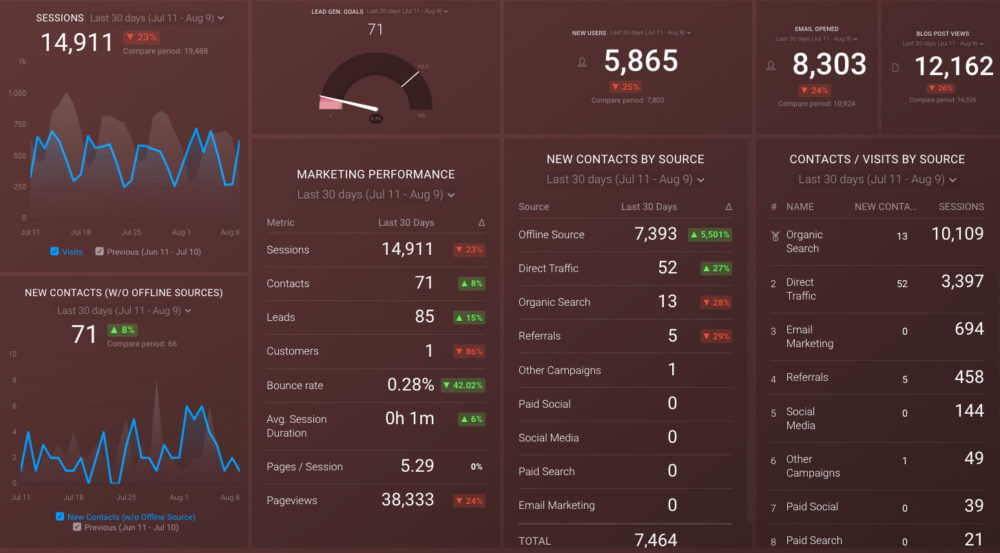

To see what Databox can do for you, including how it helps you track and visualize your performance data in real-time, check out our home page. Click here.
A blank page can look terrifying.
You make yourself a cup of nice, hot coffee, sit in your comfy chair, and open a new document, but… Your strategy report won’t write itself.
And when you have no idea where to start or how to make your report look professional, neat, and above all, compelling, minutes may go by without you writing a single word.
But what if we told you things didn’t need to be that hard? That you could write exceptional strategy reports by following a simple guide encompassing both the report’s structure and contents?
That’s exactly what we’re about to share with you! Without further ado, let’s get started.

Writing a strategic report can be crucial for your business growth.
In this type of report, you look at your strategy (either overall business strategy or by department – marketing, financial, etc.) and analyze its performance over a specific time period – usually monthly or annually.
When writing a marketing strategy report, you typically take a look at the results of different activities and plans you’ve implemented, and compare your current status to the goals you’ve set before a specific time period. You may also compare your current results to the last year’s figures, so you can see where you stand and evaluate your progress, or the overall business goals of the company.
A strategy report also presents possible action plans for the future, based on the performance analysis.
Based on your strategy report, you can determine what changes you want to introduce, what elements of the strategy you want to keep and replicate, and what activities turned out to be unsuccessful.
Some experts separate the contents of their strategy reports into three categories that answer the three primary questions about their business, or in this case, marketing strategy:
These questions are actually a good illustration of any strategy. You have a starting point, at which you want to revisit your goals, mission, and vision of the business you want to have in the future. If there have been any changes to these, you should redefine them in the strategy report.
While looking at your current situation, it’s also a good idea to perform a SWOT analysis (strengths, weaknesses, opportunities, threats) and bear them in mind while writing the report.
You also have a set of goals you want to achieve. To get there, you need to have a strategy. It’s a well-defined plan with clear, actionable steps that you can take (and measure in the process) to get to your marketing goal. It’s essential that the activities you complete can be measured because that’s how you track your progress and improve your strategy over time.
While building your path towards your goals, you should be aware of your competition, as well. Do you have a sustainable advantage that helps you stand out from your competitors? In what ways can you make it even better, or at least maintain it? Your unique selling point is something you should nurture to stay competitive.
Don’t neglect your short-term goals, either. Every great goal can be broken down into smaller objectives and everyday completions of these smaller goals eventually lead to bigger progress towards the greater business goals. Where you see yourself tomorrow is just as important as where you see yourself in ten years.
Like most marketers and marketing managers, you want to know how your efforts are translating into results each month. How is your website performing? How well are you converting traffic into leads and customers? Which marketing channels are performing best? How does organic search compare to paid campaigns and to previous months? You might have to scramble to put all of this together in a single report, but now you can have it all at your fingertips in a single Databox dashboard.
Our Monthly Marketing Performance Dashboard includes data from Google Analytics 4 and HubSpot Marketing with key performance metrics like:
Now you can benefit from the experience of our Google Analytics and HubSpot Marketing experts, who have put together a plug-and-play Databox template that contains all the essential metrics for monitoring and analyzing your website traffic and its sources, lead generation, and more. It’s simple to implement and start using as a standalone dashboard or in marketing reports, and best of all, it’s free!

You can easily set it up in just a few clicks – no coding required.
To set up the dashboard, follow these 3 simple steps:
Step 1: Get the template
Step 2: Connect your HubSpot and Google Analytics 4 accounts with Databox.
Step 3: Watch your dashboard populate in seconds.